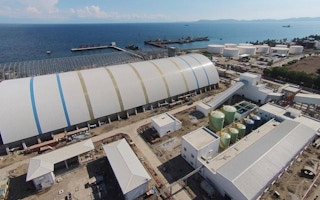The cost of retiring all coal plants in the Philippines up to five years before the end of their lifespan is estimated at US$10.6 billion, according to a study by London-based non-profit Transition Zero.
To continue reading, subscribe to Eco‑Business.
There's something for everyone. We offer a range of subscription plans.
- Access our stories and receive our Insights Weekly newsletter with the free EB Member plan.
- Unlock unlimited access to our content and archive with EB Circle.
- Publish your content with EB Premium.
The projected outlay would include buying out the fleet’s power supply agreements (PSA) based on the yearly cost of the electricity generated by each coal plant from 2020 to 2023.
The Philippines currently has 32 coal-fired plants, comprised of 58 coal units, which generate 12.2 gigawatts (GW) of installed capacity.
The expense of early retirement does not include the cost of replacing the coal plants with solar and battery storage, which is projected to amount to US$99 for every tonne of carbon dioxide (tCo2) the coal plant emits, said Isabella Suarez, engagement analyst of Transition Zero.
“The energy transition is a massive opportunity for the Philippines to pursue decarbonisation and energy security in tandem. This means thinking about how coal refinancing can also enable the deployment of clean alternatives and the enhancement of the grid,” Suarez, lead author of the report, told Eco-Business.
“Energy transition deals need to ensure that new, clean capacity is able to come online. Financing needs to be allocated accordingly as the cost of replacing these high-capacity projects with solar and storage is quite high,” she added.
Power generation companies may have to pay utilities like Manila Electric Company (Meralco), the country’s largest power distribution company, for the cost of terminating their plant’s PSA, which may be contracted for up to 25 years for large-scale units.
For deals that do not involve buying out PSAs, the value of the coal plant is based on future revenues or the amount of money a business can realistically expect to earn from sales, along with the fixed capital cost and operating cost related to the asset.
Unlike Indonesia where each coal plant delivers power under only one purchase agreement, the electricity sector in the Philippines is more liberalised, noted the report.
It is common for one Filipino coal plant to have contracts with several PSAs. Retirement strategies could include shutting down one unit first, or buying out generation instead of capacity, it read.
The coal plant owner is then encouraged to reinvest in clean dispatchable alternatives like solar and battery storage which are necessary to meet grid stability and increasing demand.
Gearing up for the Philippines’ first coal plant phase-out
Despite the Philippine government declaring four years ago that it will no longer approve applications for the new construction of coal-fired power plants and its aim to reach a 35 per cent renewable energy target by 2030, only two coal-fired plants have decommissioning plans.
The South Luzon Thermal Energy Corporation (SLTEC) plant in Calaca, Batangas, which only started operating commercially in 2015, has a retirement date set for 2030.
ACEN, the energy platform of the Filipino conglomerate Ayala Group, fully divested from SLTEC more than a year ago using a mechanism that will enable the early retirement of the 246 megawatt (MW) coal plant and transition it to clean technology by 2040.
Meanwhile, the 232 MW Mindanao Steag coal power station in Misamis Oriental in Davao is poised for early retirement, but a date has not yet been set.
Both facilities were selected for early phase-out under a test of new “transition credits” to hasten the early retirement of Asia’s young coal-fired power plants by the Monetary Authority of Singapore’s (MAS), Singapore’s central bank and regulator.
Transition credits, or carbon credits that can be generated from emissions reduced when high-emitting assets like coal-fired power plants (CFPPs) are retired early and replaced with cleaner energy sources, have been suggested by MAS as a complementary financing mechanism to close the economic gap for decommissioning the region’s 5,000 or so power plant units which are below 15 years old on average.
For the Philippines, retiring coal plants five years ahead of schedule could prevent 290 metric tonnes of carbon dioxide equivalent, almost double the country’s annual carbon emissions from the fossil fuels industry, noted the Transition Zero report.
The study added: “To catalyse refinancing for early retirement, the Philippines requires a clear policy-driven incentive. Although the country’s fleet is young compared to others in Southeast Asia, retiring coal plants five years early could lead to their decommissioning by 2040.”
Want more Philippines ESG and sustainability news and views? Subscribe to our Eco-Business Philippines newsletter here.

















